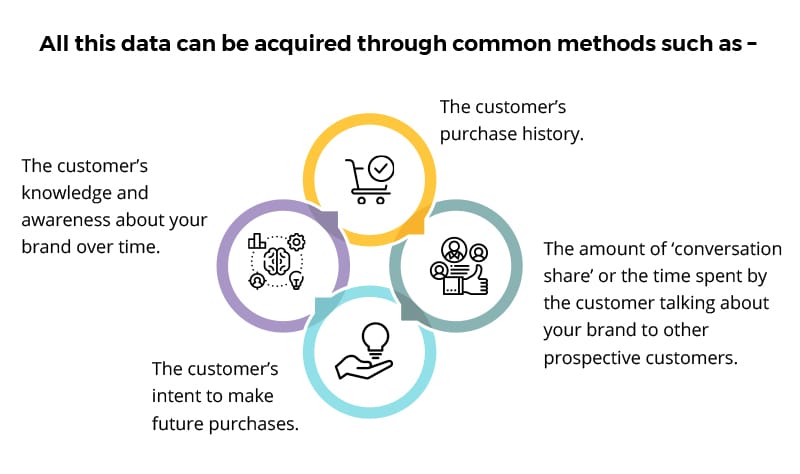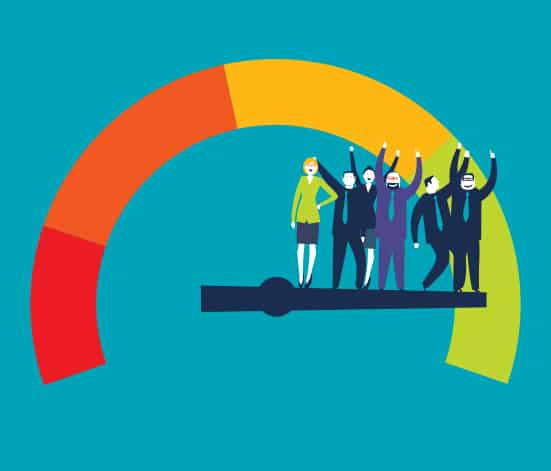How to Measure Brand Equity – Understanding and Elevating your Brand
Customers are now the prime focus of companies, with products and services coming in second. With companies offering the best customer experiences that money can buy and technology can support, the expectations of customers have also been heightened. A 2020 report suggests that “74% of customers expect more from brands”, not just from their products and services, but regarding how they “treat their customers, employees, and the environment.” And customers are also loyal to brands that meet their expectations, gain their trust, and brands they have thus come to recognize.
Very simply put, Brand Equity is the perceived value that is added to a brand name on account of being easily identifiable and having a history of creating positive experiences for customers. This public perception counts for a lot in a market environment where your brand needs to trump its competitors. Your brand can have multiple competitors offering similar products at cheaper prices; but if you have established brand equity, just the perception alone will increase customer retention and make new customers choose your products over others.
Brand equity and its impact follow a self-fulfilling cycle. The very concept creates a market environment that favors companies with greater brand equity. Your revenue will continue to rise as customers choose your brand based on perception, even if competitors offer cheaper substitutes. The goodwill and brand awareness you generate further elevates your brand equity and creates business opportunities for the future.
Brand Value vs Brand Equity
Brand value and brand equity are both educated estimations of the worth of a brand. We view the financial worth of a company as its brand value. It is the monetary valuation of the brand in the current market conditions.
On the other hand, brand equity is the perception of the brand and the value attached to it by customers, vendors, and channel partners.
Approaches to Measuring Brand Equity
While trying to build your brand or while working with an established brand, you need brand tracking to monitor progress over time, and measure the progress to understand its strength in the relevant market. Computing economic data (O data) and emotional data (X data) are the two broad approaches towards measuring brand equity.
Economic data is essentially operational data from finance, product development, sales, and HR departments. Being numerical and historical, they can be calculated to generate data sets, but they can only help you understand your brand’s performance history. Predictions can be made on trends in the past, but they aren’t always accurate as this does not consider the customer’s sentiments. Hence the necessity for the second approach.
Emotional data lets you measure brand equity based on customer experience (CX) data. Helping to understand the qualitative reasons behind customer decisions based on sentiment, and how a customer perceives your brand. If you can understand your customer’s emotions, you can portray your brand image accordingly. This enables customers to identify with your brand, remodel their self-image according to your brand’s ethos and choose your premium product over a competitor’s.
Brand measurement using both data sets and viewing them parallelly can offer you a comprehensive view of your brand equity. And a strong brand image not only helps generate new customers and retain loyal ones but also attracts a motivated workforce who adds to the overall value of your business.
Impact of Brand Equity on ROI
Having high brand equity and being a recognized brand has its perks and leads to an improvement in the Return on Investment (ROI). The following are the two major benefits:
Higher Order Value:
Brands with positive brand equity not only attract more customers, but customers are willing to spend more on their products. Even if competitors offer cheaper products of the same quality, customers will choose the more expensive one simply for the value the brand name carries.
Lower Marketing Spend:
If a brand is preceded by a good reputation, because of quality products and premium customer experience; customers will look you up, make purchases, and will spread your reputation further by word of mouth. Not only do you have to then spend less on advertising your brand, but you can also improve the effectiveness of your marketing spending with new products selling easily because of the trust and goodwill that has been established. Customer loyalty is an asset every brand should cultivate and maintain. Good brand equity will help you achieve that, and consequently enhance the Customer Lifetime Value. And if your brand is going public, nothing improves stock prices better than strong brand equity to fortify the value of the brand in the minds of consumers and shareholders alike.
Measuring Brand Equity
Once you have your approaches chalked out, you can measure your brand equity across the following dimensions and make a positive impact on your brand’s performance.
1 Brand Awareness:
This essentially is how well your brand is known in the market, by target customers and stakeholders. Brand awareness is emotional data and can be gauged through a process such as questionnaires which target –
- The customer’s knowledge and awareness about your brand over time.
- The customer’s intent to make future purchases.
- The customer’s purchase history.
- The amount of ‘conversation share’ or the time spent by the customer talking about your brand to other prospective customers.

2 Consumer Preference Metrics:
Consumer preference is one of the driving forces behind why the customer wants to avail a specific product or service. It is the reason why they may choose to spend more or travel further to engage with your brand and not a competitor offering cheaper substitutes. The following facets of customer preference can be measured with the help of sales data analysis, customer surveys, and focus groups –
- Brand relevance measures how unique and specific is the value offered by your brand to its customers, in comparison to competitors.
- Ease of access to products and services that you offer.
- Strong emotional connections with your customer base enable you to meet their needs, help them identify with your brand, build trust, and foster loyalty.
- Brand value to help you gauge how much your customers are willing to spend on your products and services.
3. Channel Partners:
Just as important as the consumers, channel partners have a major role in determining your brand equity and consumer preference. You need to ensure that channel partners comply with brand guidelines and adopt systems your company has put in place while engaging in local or national campaigns. Company culture also becomes important here, because how you treat and work with your channel partners will determine their commitment to your brand and their efforts to enhance your brand equity.
4. Financial Sales Metrics:
Directly associated with a brand’s sales performance, if the financial metrics of your company are improving, there is a relevant increase in the revenue generated and the overall brand equity.
The following financial metrics can be leveraged to measure brand equity –
- Local store retail
- Premium prices
- Average transaction value
- Customer lifetime value
- Sustained growth rate
5. Competitive Metrics:
Your brand equity can be directly influenced by the brand equity of a competitor. Adjustments in branding, marketing, or sales in one brand, can affect customer preferences for the other. If your potential customers are in the market looking for but not being able to access products or services that fit their specific requirements, have high-quality design and longevity, are not overpriced for the value they offer, and can deliver a satisfactory experience, these are the opportunities your brand needs to capitalize on. Practice brand analytics, anticipate and address the market requirements, stay ahead of your competitors, and watch your equity grow.
6. Output Metrics:
This is a measure of all the marketing activities being undertaken by your brand and all the marketing assets being released for public consumption. It identifies not just the type of assets, but the frequency of them being released in the market. This output can also be measured by the impact that offers have on local sales. Local sales and business activities are crucial to your brand equity because local store owners using and promoting your products greatly influence sales, consumer mentality, and a sense of trust in your brand.
Elevating Brand Equity
Brand equity is developed and built at every touchpoint that customers engage and interact with your brand. Whether it is a digital advertisement, or a physical advertisement, or simply a local store owner spreading your brand identity by word-of-mouth; every touchpoint is an opportunity for brand managers to create a positive impression in the customer’s mind. Elevating brand equity has to be a gradual process where the equity can be measured and employees can focus on enhancing every touchpoint for optimizing the customer’s journey and offering the best experience possible.
A few things you need to focus on for building up your brand equity; are building a national brand, improving performance in local markets, and fostering local innovation.
- Brand managers more often than not, supervise national-level campaigns but not local marketing initiatives. Whether your brand is running a national or global campaign, you always have to start local. Leverage channel partners to feel the pulse of the local market environment and reinforce your brand at the local level. Collect feedback to improve not just products but the promotions themselves, so that you can appeal to the right customer base. Have clear brand visibility along with a strong digital presence to accompany the physical locations. Maintain brand consistency across every location and touchpoint because inconsistent product quality and brand experience is the quickest way to decrease brand equity.
- Providing premium customer experiences at the local level, combined with high-quality products and consistent services across the country, is a great way to build your brand equity. If you can provide your customers with an exceptional experience after they were attracted by an ad campaign and opted for your product, it’s great for your brand equity. If you can succeed at the local level, you will be recognized at the national level, and consistency in approach and delivery will keep building your brand equity.
- Sustainability is the order of the day, with brands across industries shifting to sustainable and eco-friendly business models. Whether it is in the manufacturing process, or product packaging, or the very product itself, a sustainable model not only lets you improve your brand equity and set yourself apart from the competition, but gives potential customers a strong reason to select your brand and its offerings over the others in the market.
- Innovation at the local level is key to rooting out repetition and redundancy. Customers want ads to excite them, products to intrigue them, and services to be top-notch. You can’t afford to keep using the same campaigns and hope to succeed. Understand your customer base and their needs, and let innovation transform your regular campaigns into something attractive. Even if you are offering a similar deal, if it can be rewired to hit the right chords with the customers, it is the innovative approach that brings them in. Foster innovation, promote customer engagement, provide premium experiences with consistency, and your brand equity will skyrocket.
With customers becoming the point of focus, organizations have to pay a lot of attention to the brand image they are portraying and how business activities impact and contribute to the overall brand equity at every touchpoint. Digital Analytics is the answer to figuring out how your brand is performing, how your consumers are responding, and what can be done to improve business processes, products and services, customer engagement, and the overall enhancement of the customer’s journey.
We, at Course5 Intelligence, can help you understand your brand better, address your customers more effectively and build your brand equity over time.
Don’t miss our next article!
Sign up to get the latest perspectives on analytics, insights, and AI.




